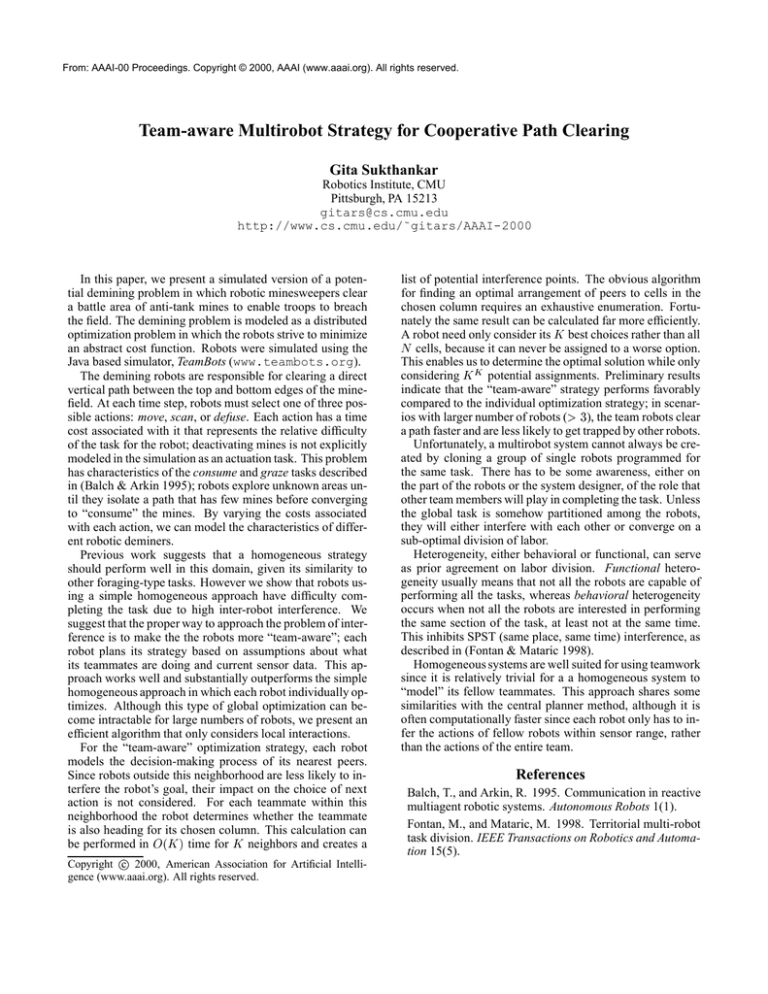
From: AAAI-00 Proceedings. Copyright © 2000, AAAI (www.aaai.org). All rights reserved.
Team-aware Multirobot Strategy for Cooperative Path Clearing
Gita Sukthankar
Robotics Institute, CMU
Pittsburgh, PA 15213
gitars@cs.cmu.edu
http://www.cs.cmu.edu/˜gitars/AAAI-2000
In this paper, we present a simulated version of a potential demining problem in which robotic minesweepers clear
a battle area of anti-tank mines to enable troops to breach
the field. The demining problem is modeled as a distributed
optimization problem in which the robots strive to minimize
an abstract cost function. Robots were simulated using the
Java based simulator, TeamBots (www.teambots.org).
The demining robots are responsible for clearing a direct
vertical path between the top and bottom edges of the minefield. At each time step, robots must select one of three possible actions: move, scan, or defuse. Each action has a time
cost associated with it that represents the relative difficulty
of the task for the robot; deactivating mines is not explicitly
modeled in the simulation as an actuation task. This problem
has characteristics of the consume and graze tasks described
in (Balch & Arkin 1995); robots explore unknown areas until they isolate a path that has few mines before converging
to “consume” the mines. By varying the costs associated
with each action, we can model the characteristics of different robotic deminers.
Previous work suggests that a homogeneous strategy
should perform well in this domain, given its similarity to
other foraging-type tasks. However we show that robots using a simple homogeneous approach have difficulty completing the task due to high inter-robot interference. We
suggest that the proper way to approach the problem of interference is to make the the robots more “team-aware”; each
robot plans its strategy based on assumptions about what
its teammates are doing and current sensor data. This approach works well and substantially outperforms the simple
homogeneous approach in which each robot individually optimizes. Although this type of global optimization can become intractable for large numbers of robots, we present an
efficient algorithm that only considers local interactions.
For the “team-aware” optimization strategy, each robot
models the decision-making process of its nearest peers.
Since robots outside this neighborhood are less likely to interfere the robot’s goal, their impact on the choice of next
action is not considered. For each teammate within this
neighborhood the robot determines whether the teammate
is also heading for its chosen column. This calculation can
be performed in O(K ) time for K neighbors and creates a
Copyright c 2000, American Association for Artificial Intelligence (www.aaai.org). All rights reserved.
list of potential interference points. The obvious algorithm
for finding an optimal arrangement of peers to cells in the
chosen column requires an exhaustive enumeration. Fortunately the same result can be calculated far more efficiently.
A robot need only consider its K best choices rather than all
N cells, because it can never be assigned to a worse option.
This enables us to determine the optimal solution while only
considering K K potential assignments. Preliminary results
indicate that the “team-aware” strategy performs favorably
compared to the individual optimization strategy; in scenarios with larger number of robots (> 3), the team robots clear
a path faster and are less likely to get trapped by other robots.
Unfortunately, a multirobot system cannot always be created by cloning a group of single robots programmed for
the same task. There has to be some awareness, either on
the part of the robots or the system designer, of the role that
other team members will play in completing the task. Unless
the global task is somehow partitioned among the robots,
they will either interfere with each other or converge on a
sub-optimal division of labor.
Heterogeneity, either behavioral or functional, can serve
as prior agreement on labor division. Functional heterogeneity usually means that not all the robots are capable of
performing all the tasks, whereas behavioral heterogeneity
occurs when not all the robots are interested in performing
the same section of the task, at least not at the same time.
This inhibits SPST (same place, same time) interference, as
described in (Fontan & Mataric 1998).
Homogeneous systems are well suited for using teamwork
since it is relatively trivial for a a homogeneous system to
“model” its fellow teammates. This approach shares some
similarities with the central planner method, although it is
often computationally faster since each robot only has to infer the actions of fellow robots within sensor range, rather
than the actions of the entire team.
References
Balch, T., and Arkin, R. 1995. Communication in reactive
multiagent robotic systems. Autonomous Robots 1(1).
Fontan, M., and Mataric, M. 1998. Territorial multi-robot
task division. IEEE Transactions on Robotics and Automation 15(5).


